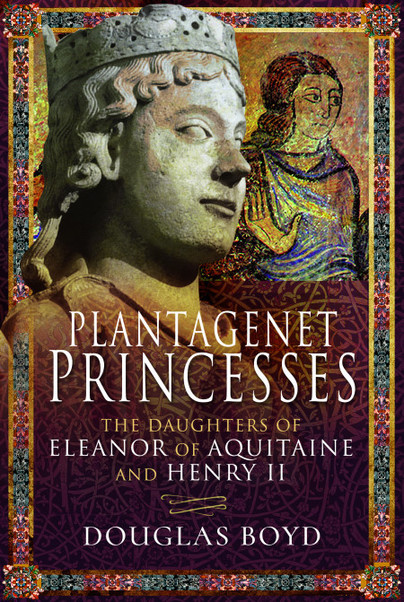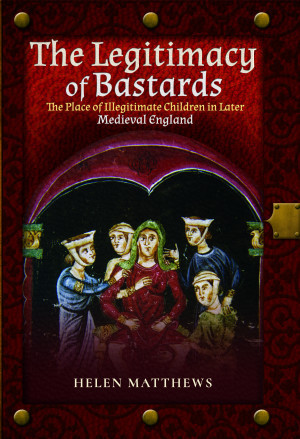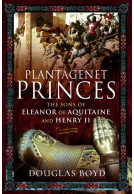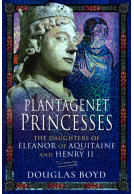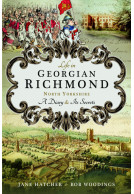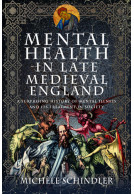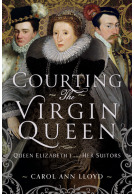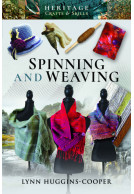Plantagenet Princesses (Hardback)
The Daughters of Eleanor of Aquitaine and Henry II
Imprint: Pen & Sword History
Pages: 242
Illustrations: 20 b/w illustrations
ISBN: 9781526743107
Published: 11th March 2020
History Hit!
An article written by the author for Dan Snow's History Hit: 'What Happened to Eleanor of Aquitaine's Daughters?'
(click here for international delivery rates)
Order within the next 6 hours, 9 minutes to get your order processed the next working day!
Need a currency converter? Check XE.com for live rates
| Other formats available | Price |
|---|---|
| Plantagenet Princesses Paperback Add to Basket | £11.99 |
The names of few medieval monarchs and their queens are better known than Eleanor of Aquitaine, uniquely queen of France and queen of England, and her second husband Henry II. Although academically labelled ‘medieval’, their era was the violent transition from the Dark Ages, when countries’ borders were defined with fire and sword. Henry grabbed the English throne thanks largely to Eleanor’s dowry because she owned one third of France.
Their daughters also lived extraordinary lives. If princes fought for their succession to crowns, the princesses were traded – usually by their mothers – to strangers for political power without the bloodshed. Years before what would today be marriageable age, royal girls were despatched to countries whose speech was unknown to them and there became the property of unknown men; their duty the bearing of sons to continue a dynasty and daughters who would be traded in their turn.
Some became literal prisoners of their spouses; others outwitted would-be rapists and the Church to seize the reins of power when their husbands died. Eleanor’s daughters Marie and Alix were abandoned in Paris when she divorced Louis VII of France. By Henry II, she bore Matilda, Aliénor and Joanna. Between them, these extraordinary women and their daughters knew the extremes of power and pain. Joanna was imprisoned by William II of Sicily and worse treated by her brutal second husband in Toulouse. If Eleanor was libelled as a whore, Aliénor’s descendants include two saints, Louis of France and Fernando of Spain. And then there were the illegitimate daughters, whose lives read like novels…
Research for this book is excellent and the pictures, index and notes are necessary and helpful in following the intriguing and interesting family trees of the mediaeval families mentioned. You need plenty of time to read this book. It cannot be more highly recommended.
Family and Community Historical Research Society Newsletter, Volume 22, November 2021
When I had the opportunity to read this I jumped at the chance as I adore royal history and though I would say that I’m very knowledgeable in the subject, I discovered facts that I wasn’t aware of. All in all, an easy to read non fiction book with some excellent characters.
NetGalley, Joanne Tinkler
Knowing relatively little about this period of history I found the book instructive as well as enjoyable – and despite the 800 years that separate us from the Plantagenet Princesses there are interesting parallels with the ways in which modern politicians with dynastic ambitions manoeuvre their family members into positions of authority!
Lost Cousins
Read the full review here
Eleanor of Aquitaine is one of my favorite medieval queens and this was an insightful look into the lives and influences of her three daughters, Matilda, Eleanor, and Joanna.
NetGalley, Melisa Safchinsky
I Britain's Dark Ages ended with Duke William of Normandy's triumph over Harold, and the Middle Ages began, with several centuries of dominant personalities and turbulent times, sometimes much worse than what had gone on in the previous centuries. Douglas Boyd describes the daughters of Eleanor of Aquitaine and Henry II, Marie, Alix, Matilda, Alienor and Joanna, and their ultimately fantastic power-wielding lives. Absolutely riveting reading.
Books Monthly
Alienor of Aquitaine was a rich heiress who was placed in a loveless marriage with Louis the Pious, King of France. Divorced after several years during which she only gave birth to daughters, Alienor became Eleanor, wife of Henry II of England and thus a strong female dynasty was founded.
NetGalley, Jo-anne Atkinson
In this book the legacy of Eleanor in terms of the female line is explored and it is fascinating. much is written about the Kings of England but the web of intermarriage between the branches of the royal families is the true source of power. Over 100 years the lives of the famous and the forgotten are considered, from Margaret of France, a true she-wolf and wife to the incompetent Edward II to the obscure Constance of Brittany and a couple of Welsh ladies. OK so most the women had similar names and it can become tricky to follow at times but this is a really interesting book that places women in the context of their times
Rating: 5 out of 5 stars
NetGalley, Sylwia Zupanec
Douglas Boyd's biography of Eleanor of Aquitaine, "The April Queen", is one of my favourite bios of this queen. I was naturally excited to read Boyd's newest book treating about Eleanor's daughters.
Eleanor of Aquitaine is a figure larger than life. She was wife, mother and grandmother of kings and a rich heiress in her own right. I will never tire of reading books about her although most of popular biographies depict her as legendary, perpetuating many myths.
Eleanor overshadows many of her successors while her daughters are all but forgotten. She had five daughters in total (if there were more, history didn't record their existence). Two, Marie of France, Countess of Champagne and Alix, Countess of Blois, were born during Eleanor's tempestuous first marriage to Louis VII of France. That marriage ended in annulment in 1152.
Eleanor's second husband was Henry Plantagenet, Duke of Normandy, who became Henry II of England in 1154. With him she had about ten children in total, among them three sons who became kings: Henry the Young King, Richard the Lionheart and John I.
While Eleanor's sons are famous, her daughters remain on the fringes of history although they married into the upper echelons of European nobility: Matilda (named after her illustrious grandmother Empress Matilda) became Duchess of Saxony, Eleanor (named after her mother) became Queen of Castile and Joan became Queen of Sicily.
Little is known about Eleanor's daughters with Louis VII while the lives of her daughters with Henry II are far better documented. In this book, Douglas Boyd charted their lives to show what it was like to live during the Middle Ages as a powerful woman. The book gave a lot of details of these women's lives and enriched my knowledge of the period.
If you like to read about Eleanor of Aquitaine, I'm sure you'll enjoy this book.
Being interested in the Plantagenets I was excited to receive this book. I found it to be very interesting and it helped me better understand the relationships between some of the individuals.
NetGalley, Amy McElroy
Personally I found it intriguing and it's very well researched.
A fascinating look into the past. This author has a fluid writing style that is easy to understand. A very enjoyable read.
NetGalley, Haley Lossing
Rating: 5 out of 5 stars
NetGalley, Maria Martignetti
This is soooo my genre and time in history and was thrilled to be able to read this.
Women do get a raw deal when it comes to history and the way they are written about so this is such a worthwhile book.
Love Eleanor of Aquitaine and there is much already in place re her - I loved the extra knowledge this tome gave me - loved the way her character is fleshed out here.
Its great to see women portrayed they way they are in this book.
If history is your think, you can do no better than this well researched, fascinating book - one of my must reads this year.
Rating: 5 out of 5 stars
NetGalley, Rebecca Hill
The role of women in history has often been hard to decipher. Since much of what we know of the women comes from the brief snatches of history that we get from their menfolk, fleshing out these powerful women in their own right has never been easy.
Eleanor of Aquitaine is probably one of the best recorded, as she was very active in her role as Countess and Queen. The fact that she queen of France, who then divorced her husband and then married Henry, going on to become the queen of England raised some scandal - and a lot of documentation on her. When she rebelled against her husband with her four sons later on, that alone would have secured her role in history. But she was more than just a trophy - she was active, issuing charters in her own right.
The women portrayed in this book bring a new life to many of these women to have been mere footnotes in history before. This was a great book and one that I really enjoyed reading.
There are a lot of names and places. It is easy to get confused. Grab a piece of paper and make notes - you are going to need them!
The daughters of Eleanor and Henry have gotten way too little attention (aside from Joan, anyway) so it was about time they got their own book.
NetGalley, Maja Hansen
About Douglas Boyd
Douglas Boyd’s historical writing began with scripting dramatic reconstructions when a BBC Television staff producer/director. For the past 30 years he has been writing full-time, based in the Plantagenet heartland of southwest and western France. His books have been translated into seventeen languages.
The Legitimacy of Bastards The Place of Illegitimate Children in Later Medieval England (Hardback)
For the nobility and gentry in later medieval England, land was a source of wealth and status. Their marriages were arranged with this in mind, and it is not surprising that so many of them had mistresses and illegitimate children. John de Warenne, earl of Surrey, married at the age of twenty to a ten-year-old granddaughter of Edward I, had at least eight bastards and a complicated love life. In theory, bastards were at a considerable disadvantage. Regarded as ‘filius nullius’ or the son of no one, they were unable to inherit real property and barred from the priesthood. In practice, illegitimacy…
By Helen MatthewsClick here to buy both titles for £50.00







